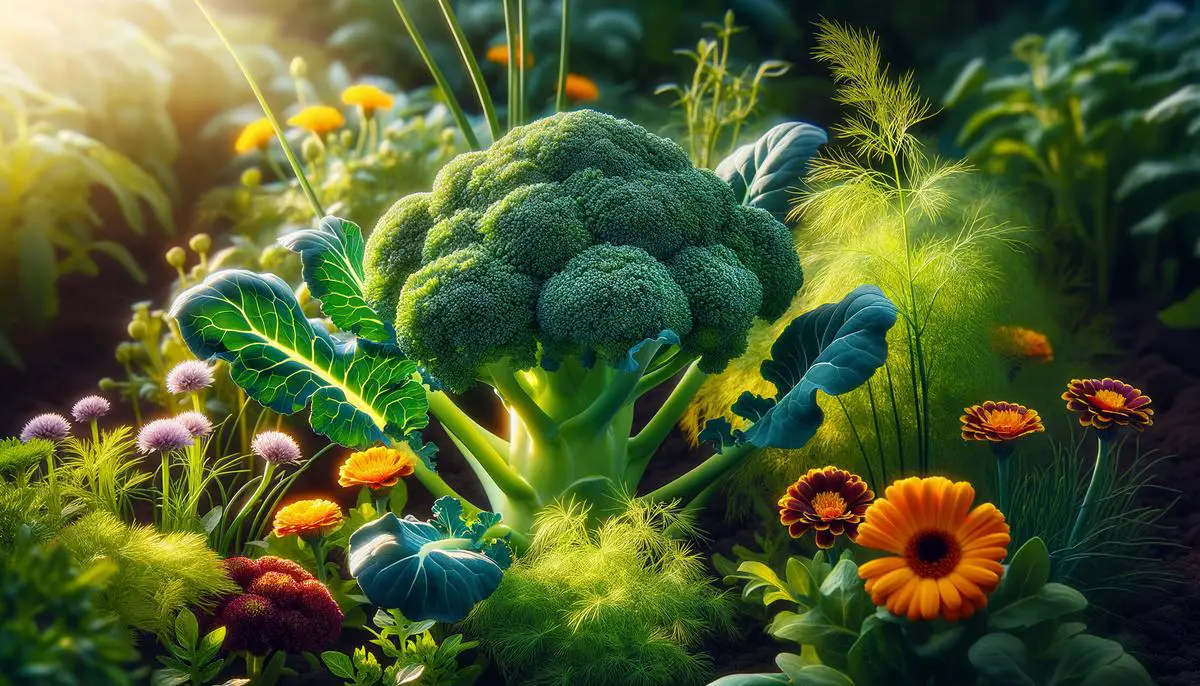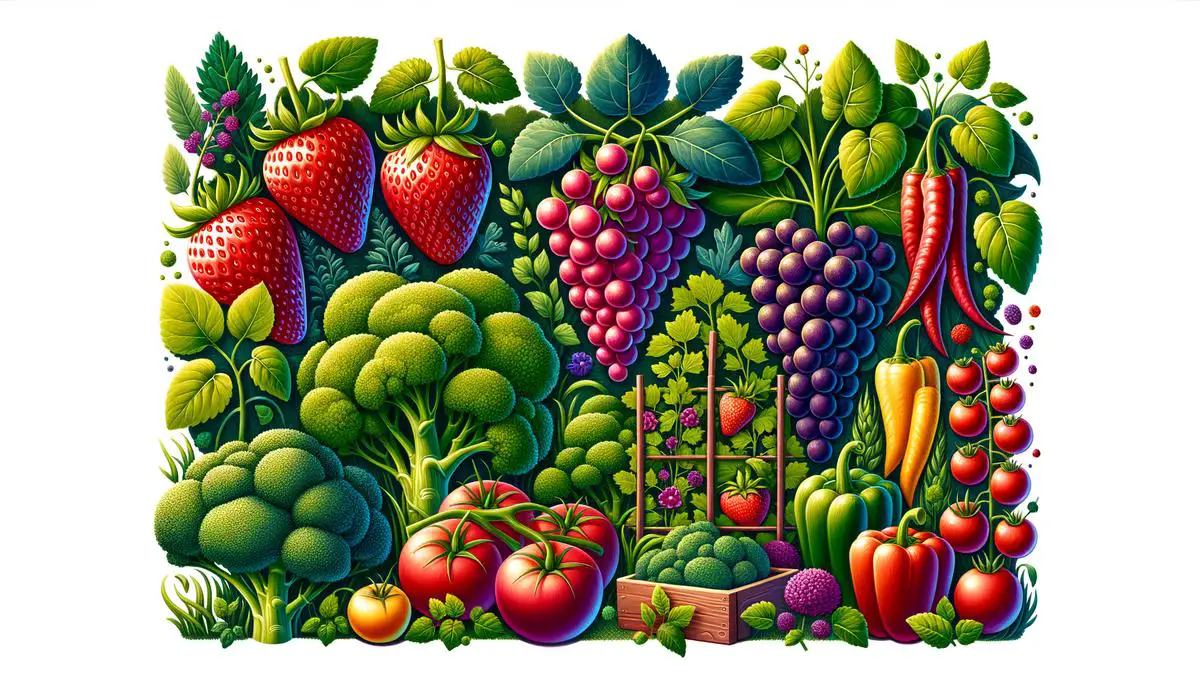Exploring the realm of companion planting opens up new avenues for enhancing how we grow our vegetables, especially broccoli. This age-old method of placing certain plants together aims to create a supportive environment, maximizing growth and health among our green allies. By focusing on this natural collaboration, we not only benefit our plants but also elevate our gardening practices to a more productive and sustainable level.
Understanding Companion Planting
Why Companion Planting is Critical for Broccoli
Reader Poll: What online courses would interest you?
Let’s dive straight into the verdant world of broccoli and its buddies in the garden. Broccoli, a beloved green, craves companions in the chaotic dance of the vegetable patch. This isn’t just about keeping it company; it’s a strategic move to bolster its growth, health, and output. Companion planting, an age-old technique reining in the synergy of different plants, offers a myriad of benefits, making it a critical practice especially for broccoli cultivators.
First up, pest control. Broccoli is a magnet for certain pests, with cabbage loopers and aphids being the usual suspects. By introducing aromatic companions like onions, garlic, or sage, you’re essentially setting up a natural defense shield. These strong-scented allies repel pests, reducing the need for chemical interventions. Picture this: Garlic’s pungent aroma wafting through the air, acting as a robust barrier, keeping those greedy pests at bay.
Secondly, let’s talk about soil health and nutrient balance. Beans, a classic companion, enter the scene here. They have this fantastic ability to fix nitrogen in the soil. Broccoli, a notorious nitrogen-hogger, benefits immensely from this. It’s akin to having a friend who spontaneously replenishes your snack stash, keeping the energy up. Beans ensure that broccoli has access to its much-needed nitrogen feast, promoting lush, vibrant growth.
Subscribe to our newsletter!
Moving on, flower power plays a role too. Marigolds, with their carnival of colors, not only add visual flair but also invite beneficial insects. These insects are predators to broccoli’s foes. It’s essentially hosting a party for insect allies that, in turn, keep your broccoli thriving by keeping detrimental bugs in check.
Lastly, space maximization is a lesser-known but equally vital benefit. Planting companions like lettuce or spinach around your broccoli makes the most out of your garden space. These leafy greens have a lower profile, allowing you to fill in the gaps without crowding your broccoli. It’s like organizing a well-arranged seating chart, ensuring everyone has enough room to thrive.
In sum, companion planting around broccoli is akin to curating a carefully balanced ecosystem, where every plant plays a role in supporting the others. It’s about creating harmony in the vegetable garden, leading to healthier plants, reduced pests, and a bountiful harvest. So, when planning your garden, consider the companions for your broccoli. It’s not just about the broccoli thriving; it’s about the entire garden flourishing together.

Identifying Ideal Broccoli Companions
Continuing our exploration into companion planting for broccoli, it’s worth focusing on certain plants that offer unique advantages when grown alongside this vegetable. Understanding the synergistic relationships between broccoli and these companions can significantly enhance your gardening experience. So, let’s delve into some of the top picks that haven’t been covered yet.
Onions and Garlic
: Both are powerhouses when it comes to adding more than just flavor to your kitchen. When planted near broccoli, they serve as natural repellents for common pests like aphids and moths. The strong scents of these alliums act as a deterrent, creating a protective barrier against those pesky invaders without the need for chemical pesticides.Beans
: While we’ve talked about nitrogen-fixers, beans deserve a special mention. They are exceptional companions because they not merely enrich the soil with nitrogen but also have a compact growing habit that doesn’t compete with broccoli for space. The vertical growth of pole beans can also offer some shade to the broccoli in the peak of summer, preventing it from bolting.Radishes
: An interesting ally in the broccoli garden. These speedy growers can serve two main roles: First, radishes can act as a catch crop, meaning they attract pests away from broccoli, offering themselves up as a sacrifice. Second, their fast growth cycle breaks up the soil, helping in aeration and preventing soil compaction. This can contribute to healthier root systems for your broccoli.Herbs
: Broadening the scope of aromatic companions, herbs like rosemary and thyme not only repel unwanted insects but can actively improve the taste of broccoli when planted closely. These herbs are known for their strong scents which are not hospitable to many pests, creating a further layer of defense for your broccoli.Celery
: An underappreciated companion, celery can be beneficial in a couple of ways. It shares similar moisture and nutrient needs, making it a harmonious neighbor in the garden bed. Its strong scent may also contribute to pest deterrence, adding an extra layer of protection without additional inputs.Nasturtiums
: Although the role of flowers has been mentioned, nasturtiums earn an explicit recommendation due to their dual role. They are excellent at attracting aphids away from broccoli, acting as a trap crop. Additionally, their bright flowers lure beneficial pollinators, contributing to a healthy, balanced ecosystem in your garden.In implementing these companion planting strategies, it’s important to consider the spacing and arrangement to ensure each plant has adequate room to thrive. By incorporating these specific companions into your broccoli garden, you can expect not just a bountiful harvest but an aesthetically pleasing and ecologically balanced garden space. Remember, the goal is to create a symbiotic garden environment where each plant supports the others in growth and health.

Avoiding Antagonistic Pairings
While the symphony of companion planting often leads us to melodious harvests, certain plants, akin to discordant notes, should be meticulously avoided in the proximity of our verdant friend, broccoli. Broccoli, with its brawny green presence, might seem like a plant that could rub shoulders with just about any garden denizen. However, beneath its leafy exterior, it demands a selective social circle, ensuring its growth remains unfettered and its bounty, generous.
Strawberries: These sweet red jewels might be the pride of your garden, but when it comes to their impact on broccoli, the relationship turns sour. Strawberries and broccoli vie for the same essential nutrients, leading to a rivalry that can stunt growth and diminish yields. Keeping these two apart ensures that both can thrive without competition clouding their development.
Mustard Greens: Featuring sharp flavors and verdant leaves, mustard greens might seem like a good pairing. However, these greens can attract pests that also find broccoli appealing, leading to an increased pest presence around your broccoli plants. This mutual attraction can result in both parties suffering more damage than if they were planted apart.
Grapes: The worlds of viticulture and vegetable gardening rarely clash, but when it comes to grapes and broccoli, a definite line in the soil is drawn. The proximity of grapevines can retard the growth of broccoli, an interaction rooted in the soil chemistry and nutrient competition that grapes bring to the table. It’s best to ensure these two are planted in completely separate areas of your garden to prevent any underground turf wars.
Tomatoes: Tomato plants, with their vibrant bounty, might seem like friendly neighbors for any vegetable. However, when it comes to broccoli, they are less than ideal companions. Tomatoes and broccoli share common enemies in the insect world, potentially doubling the pest pressure on both. Moreover, tomatoes demand a substantial amount of the soil’s nutrients, which can leave broccoli in a lurch for essential growth components.
Peppers: Similar to tomatoes, peppers share common pests with broccoli, which can lead to increased infestation risks. Peppers, being part of the nightshade family, also engage in a silent competition for nutrients with broccoli, often leading to both plants underperforming.
Ensuring your broccoli is planted with the right neighbors not only fosters a harmonious garden but underscores a commitment to the well-being of each plant. By steering clear of these particular neighbors, you’re not just preventing potential growth issues; you’re setting the stage for your broccoli to become the headlining act of your garden ensemble.

Through the strategic selection of companions for broccoli, gardeners can unlock the full potential of their vegetable patches. It’s more than just about placing plants side by side; it’s about fostering a community where every member contributes to the collective well-being. The success of companion planting exemplifies the power and importance of understanding and working with nature’s intricate connections, ensuring our gardens are not just places of cultivation but vibrant ecosystems teeming with life and abundance.

